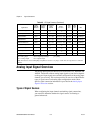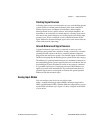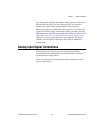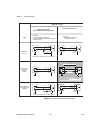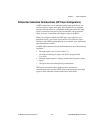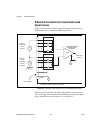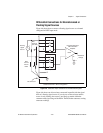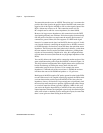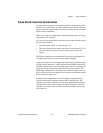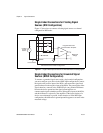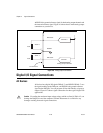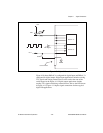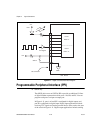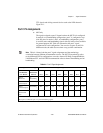Chapter 4 Signal Connections
6023E/6024E/6025E User Manual 4-16 ni.com
You must reference the source to AIGND. The easiest way is to connect the
positive side of the signal to the positive input of the PGIA and connect the
negative side of the signal to AIGND as well as to the negative input of the
PGIA, without any resistors at all. This connection works well for
DC-coupled sources with low source impedance (less than 100 Ω).
However, for larger source impedances, this connection leaves the DIFF
signal path significantly out of balance. Noise that couples electrostatically
onto the positive line does not couple onto the negative line because it is
connected to ground. Hence, this noise appears as a DIFF-mode signal
instead of a common-mode signal, and the PGIA does not reject it. In this
case, instead of directly connecting the negative line to AIGND, connect it
to AIGND through a resistor that is about 100 times the equivalent source
impedance. The resistor puts the signal pathnearly in balance, so that about
the same amount of noise couples onto both connections, yielding better
rejection of electrostatically coupled noise. Also, this configuration does
not load down the source (other than the very high input impedance of the
PGIA).
You can fully balance the signal path by connecting another resistor of the
same value between the positive input and AIGND, asshown in Figure 4-6.
This fully balanced configuration offers slightly better noise rejection but
has the disadvantage of loading the source down with the series
combination (sum) of the two resistors. If, for example, the source
impedance is 2 kΩ and each of the two resistors is 100 kΩ, the resistors
load down the source with 200 kΩ and produce a –1% gain error.
Both inputs of the PGIA require a DC path to ground in order for the PGIA
to work. If the sourceis ACcoupled (capacitively coupled),the PGIA needs
a resistor between the positive input and AIGND. If the source has low
impedance, choose a resistor that is large enough not to significantly load
the source but small enough not to produce significant input offset voltage
as a result of input bias current (typically 100 kΩ to1MΩ). In this case,
you can tie the negative input directly to AIGND. If the source has high
output impedance, balancethe signal path aspreviously described usingthe
same value resistor on both the positive and negative inputs; be aware that
there is some gain error from loading down the source.



